This manual serves as a comprehensive guide for students, providing hands-on experience in general chemistry. It covers fundamental principles, safety protocols, and essential laboratory techniques to enhance learning.
1.1 Overview of the Lab Manual
The General Chemistry Lab Manual is a detailed guide designed to support students in their laboratory coursework. It outlines essential experiments, safety protocols, and techniques to master fundamental chemistry concepts. The manual covers topics such as chemical identification, stoichiometry, and gas laws, while emphasizing proper equipment usage and data analysis. Each section is structured to promote hands-on learning, ensuring students gain practical experience alongside theoretical knowledge. The manual also includes pre- and post-lab activities to reinforce understanding and prepare for experiments effectively.
1.2 Importance of Laboratory Work in General Chemistry
Laboratory work is essential for mastering general chemistry, as it bridges theoretical concepts with practical application. Hands-on experiments enhance understanding of chemical principles, such as stoichiometry and gas laws. Labs cultivate critical thinking, problem-solving, and data analysis skills. They also emphasize safety protocols and proper equipment usage, fostering a responsible approach to scientific inquiry. Collaborative learning and teamwork are encouraged, preparing students for real-world scientific environments. Lab experiences provide opportunities to apply theoretical knowledge, reinforcing learning and developing practical skills necessary for future careers in STEM fields.

Laboratory Safety Guidelines
Laboratory safety guidelines ensure a secure environment for conducting experiments. Adhere to rules, wear PPE, and be aware of emergency procedures to prevent accidents and ensure safety.
2.1 General Safety Rules
Adherence to safety rules is crucial to prevent accidents. Wear lab coats, safety goggles, and closed-toe shoes. Tie back long hair and avoid loose jewelry. No eating, drinking, or visitors allowed in the lab. Familiarize yourself with emergency exits, fire extinguishers, and first-aid kits. Handle chemicals carefully, read MSDS, and follow proper disposal procedures. Keep work areas clean and organized. Be prepared for emergencies, such as spills or fires, by knowing the correct protocols. Your safety is a top priority in the laboratory environment.
2.2 Emergency Procedures
In case of emergencies, act swiftly and follow established protocols. For chemical spills, contain the area and use sand or absorbent materials. In case of fire, use appropriate extinguishers and evacuate the room. If skin or eyes are exposed, flush with water immediately and seek medical help. For serious injuries, call emergency services. Know the locations of emergency exits, fire extinguishers, and first-aid kits. Regular drills and familiarization with these procedures ensure preparedness and minimize risks in the laboratory setting.
2.3 Material Safety Data Sheets (MSDS)
Material Safety Data Sheets (MSDS) provide critical information about chemical products, including their composition, hazards, and safe handling procedures. They outline emergency response measures, storage requirements, and disposal methods. MSDS are essential for assessing risks and ensuring safe use of chemicals. Sections include manufacturer details, hazard identification, first aid, and environmental impact. Familiarizing yourself with MSDS ensures proper chemical management and adherence to safety protocols, minimizing potential risks in the laboratory environment.
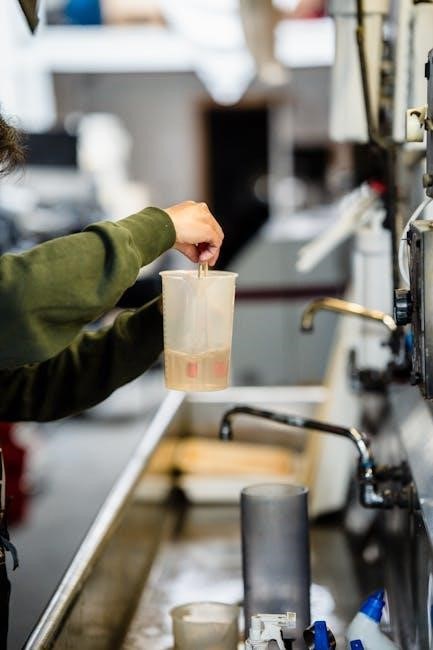
Laboratory Equipment and Tools
The lab is equipped with essential tools like beakers, test tubes, Bunsen burners, and measuring instruments. These tools are vital for conducting experiments and understanding chemical principles safely.
3.1 Essential Laboratory Equipment
The lab is equipped with fundamental tools necessary for conducting experiments. Essential equipment includes beakers, test tubes, Bunsen burners, measuring instruments, and glassware. These tools aid in mixing, heating, and analyzing substances. Additional equipment like hot plates, crucible tongs, and volumetric flasks are used for specific procedures. Understanding the proper use of each tool is crucial for accurate results and safety. Familiarizing oneself with the equipment ensures efficient and effective experimentation.
3.2 Proper Use and Maintenance of Equipment
Proper use and maintenance of laboratory equipment are essential for safety and accuracy. Always follow manufacturer guidelines and laboratory protocols when handling tools. Clean equipment after use to prevent contamination and extend its lifespan. Regularly inspect items like glassware and instruments for damage. Store equipment in designated areas to avoid breakage. Report any malfunctioning tools to the instructor promptly. Proper care ensures reliable performance and contributes to a safe working environment for everyone in the lab.
Basic Laboratory Techniques
Mastering basic lab techniques is crucial for accurate experiments. This includes precise measurements, proper use of glassware, safe handling of chemicals, and effective data recording methods.
4.1 Measurement Techniques
Accurate measurements are foundational in chemistry. Common techniques include using burettes, pipettes, and volumetric flasks for precise liquid measurements. Balances measure mass, while glassware like graduated cylinders measure volumes. Proper calibration and handling of instruments ensure reliability. Understanding significant figures and unit consistency is crucial. Data recording must be meticulous to avoid errors. Regular practice enhances proficiency, making measurement techniques a cornerstone of successful lab experiments.
4.2 Data Collection and Analysis
Systematic data collection is crucial for accurate and reliable results. Students should record observations, measurements, and calculations neatly in lab notebooks. Data organization using tables, graphs, and charts helps visualize trends and patterns. Analysis involves interpreting results, identifying inconsistencies, and drawing conclusions. Proper documentation ensures reproducibility and clarity. Error analysis, including calculating uncertainties, is essential for understanding precision. Statistical tools and graphical methods enhance data interpretation, fostering a deeper understanding of experimental outcomes and their alignment with theoretical expectations.
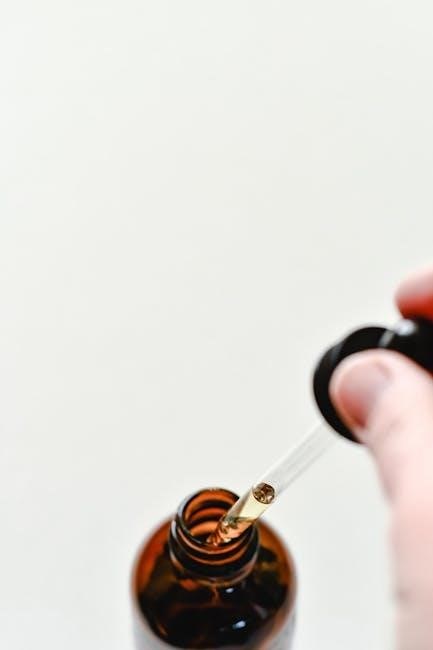
Key Experiments in the Lab Manual
The manual features experiments like chemical identification, stoichiometry, and gas laws, designed to align practical observations with theoretical concepts, enhancing students’ understanding of fundamental chemistry principles.
5.1 Chemical Identification and Qualitative Analysis
This section focuses on experiments designed to identify unknown chemical substances and analyze their properties. Students learn techniques such as titration, precipitation, and spectroscopy to determine the composition of solutions. Key experiments include identifying functional groups in organic compounds and using reagents to detect specific ions. These exercises emphasize the importance of careful observation, accurate data collection, and logical analysis in drawing conclusions about chemical identity and purity.
5.2 Stoichiometry and Gas Laws
This section explores experiments that apply stoichiometric principles and gas laws to real-world scenarios. Key experiments include determining the molar volume of gases, analyzing reaction stoichiometry, and investigating Charles’s and Boyle’s laws. Students calculate gas properties, such as pressure and volume relationships, and apply the ideal gas law to experimental data. These activities reinforce theoretical concepts and provide practical insights into chemical reactions and gas behavior.
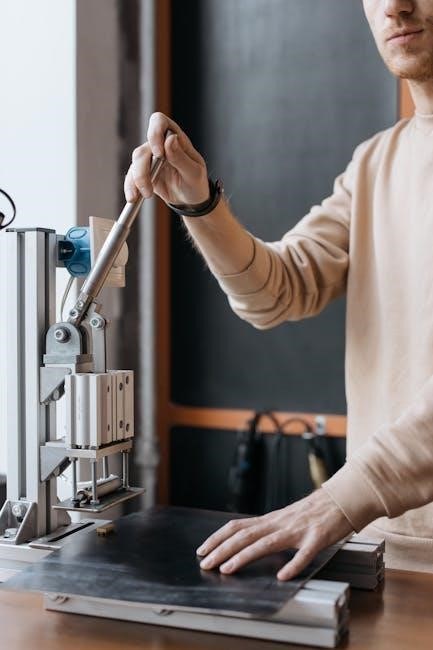
Laboratory Reports and Documentation
This section outlines the proper structure and guidelines for writing clear, concise lab reports. It emphasizes accurate data collection, analysis, and presentation to effectively communicate experimental results.
6.1 Structure of a Lab Report
A well-structured lab report typically includes an introduction, materials, procedures, results, and discussion. The introduction states the purpose and objectives, while materials list equipment and chemicals used. Procedures detail the steps taken, and results present data and observations. The discussion interprets findings, draws conclusions, and compares with theoretical expectations. Clear and concise writing ensures effective communication of scientific work, making the report informative and easy to follow for readers.
6.2 Tips for Effective Scientific Communication
Effective scientific communication requires clarity, precision, and organization. Use clear and concise language, avoiding unnecessary jargon. Ensure data is presented logically, with tables, graphs, and figures to support findings. Properly cite all references and acknowledge sources. Pay attention to grammar, spelling, and formatting. Use past tense for procedures and present tense for established facts. Always include uncertainties and limitations to maintain transparency. Peer review and proofreading can enhance the quality and readability of your report, making your work more credible and accessible to others.
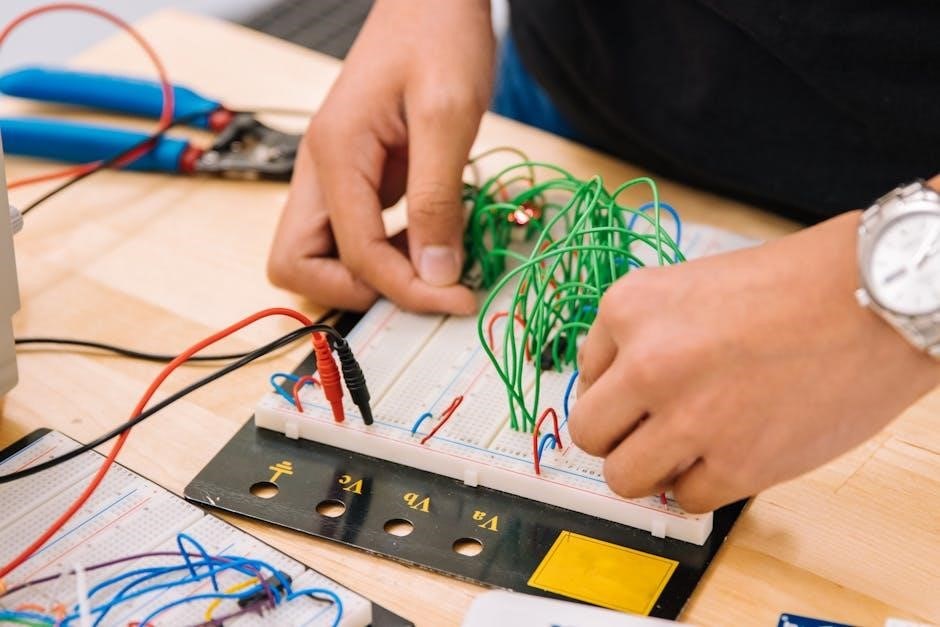
Environmental and Safety Regulations
Adhering to environmental standards and safety protocols is crucial in lab settings. Proper chemical handling, disposal, and use of Material Safety Data Sheets (MSDS) ensure compliance with regulations.
7.1 Chemical Waste Disposal
Proper chemical waste disposal is critical to maintain safety and environmental compliance. Waste should be segregated into categories such as flammable liquids, corrosive materials, and reactive substances. Use labeled, leak-proof containers for disposal, and avoid mixing different types of waste. Always consult Material Safety Data Sheets (MSDS) for specific disposal instructions. Adhere to local and institutional regulations to ensure environmentally responsible practices and minimize hazards.
7.2 Green Chemistry Practices
Green chemistry emphasizes minimizing waste and reducing the use of hazardous substances. Key practices include using alternative solvents, minimizing water consumption, and optimizing reactions to reduce byproducts. Students are encouraged to adopt atom-economy principles, ensuring reactions produce minimal waste. Catalysts are preferred over stoichiometric reagents to enhance efficiency. Additionally, experiments often utilize microscale techniques to reduce chemical usage. These practices align with sustainability goals, promoting environmentally responsible laboratory operations while maintaining scientific rigor and safety standards.
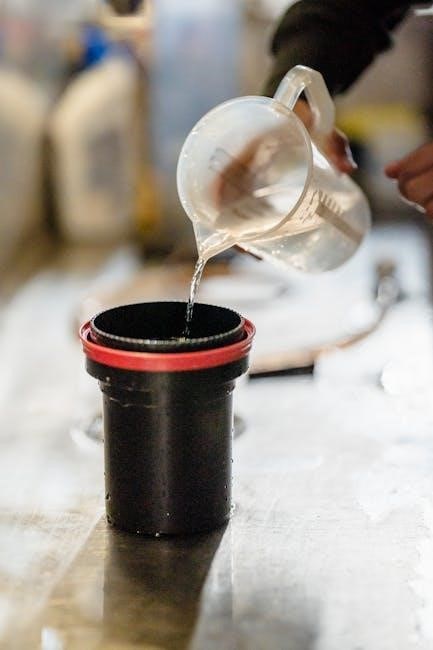
Pre-Lab and Post-Lab Activities
Pre-lab activities ensure preparation and understanding of procedures, while post-lab focuses on cleanup, disposal, and reflection, enhancing efficiency and safety in the lab setting.
8.1 Pre-Lab Preparation
Pre-lab preparation involves reviewing procedures, reading safety protocols, and gathering materials. Students must complete pre-lab questions and calculations to ensure understanding. Proper attire, including lab coats and goggles, is required. All chemicals and equipment should be checked for availability and functionality. Familiarizing oneself with Material Safety Data Sheets (MSDS) is crucial for handling chemicals safely. A well-organized workspace and prepared notebook ensure efficiency during the experiment.
8.2 Post-Lab Analysis and Reflection
Post-lab analysis involves interpreting data, comparing results with theoretical expectations, and identifying potential sources of error. Students reflect on the experiment’s success, documenting observations and calculations. Cleaning and storing equipment properly is essential. Reflection includes evaluating safety practices, procedural accuracy, and the overall learning experience. This step reinforces understanding and improves future experimental design. Accurate documentation in lab reports ensures accountability and provides a record for further analysis.

Additional Resources for Students
This section provides students with online tools, video tutorials, and recommended reading to deepen their understanding of general chemistry concepts and laboratory techniques.
9.1 Online Tools and Tutorials
Students can access various online tools and tutorials to enhance their learning experience. Platforms like PhET simulations offer interactive models for visualizing chemical processes. Video tutorials on YouTube and Khan Academy provide step-by-step explanations of complex concepts; Additionally, online labs and virtual experiments allow students to practice techniques remotely. Many universities and educational websites offer downloadable resources, such as practice problems and study guides, to supplement the lab manual. These tools are designed to reinforce classroom and laboratory learning, ensuring a deeper understanding of general chemistry principles.
9.2 Recommended Reading and References
Supplement your lab manual with textbooks like Laboratory Manual for Principles of General Chemistry by Beran or General Chemistry by John Wiley & Sons. Online resources such as NCERT lab manuals and academic publications provide additional practice problems and detailed explanations. Reference materials like Chemical Safety in the Laboratory and Experiments in General Chemistry offer practical insights. Utilize these resources to deepen your understanding of theoretical concepts and laboratory procedures, ensuring comprehensive preparation for experiments and exams.
